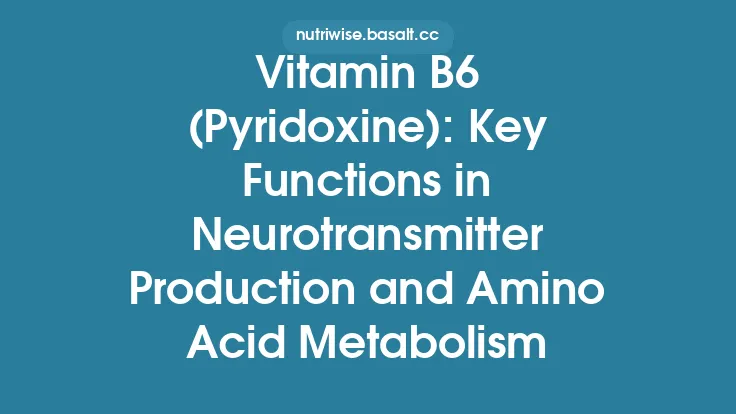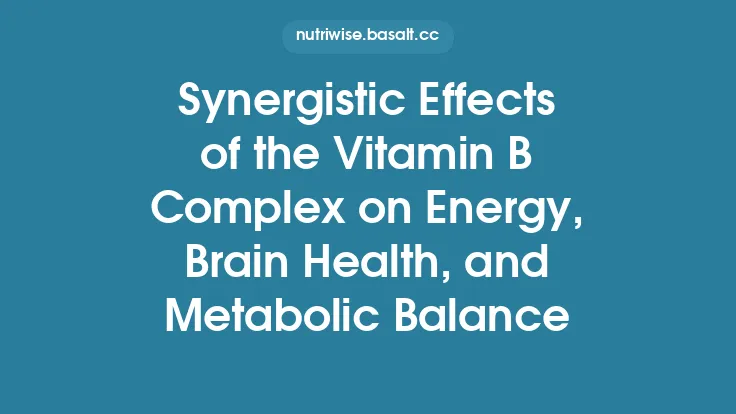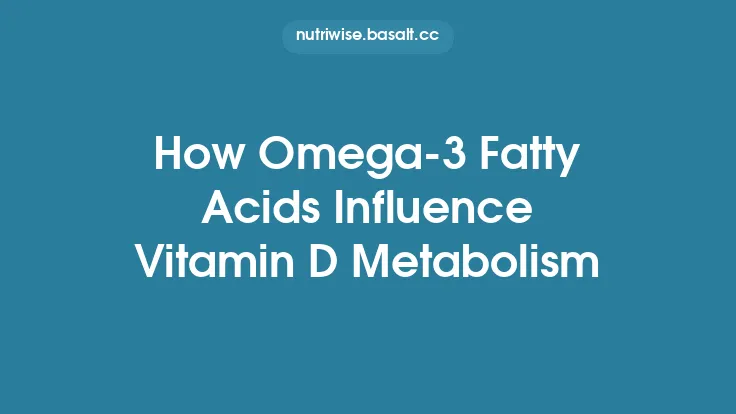Pantothenic acid, commonly known as vitamin B5, is a water‑soluble micronutrient that plays a pivotal role in the body’s biochemical orchestra. Though often overlooked in favor of its more “glamorous” B‑vitamin siblings, B5 is indispensable for the synthesis of coenzyme A (CoA), a molecular hub that links nutrient catabolism to hormone production and the mobilization of stored fat. Understanding how pantothenic acid fuels hormone synthesis and fat metabolism provides insight into its broader impact on endocrine health, energy balance, and metabolic resilience.
Chemical Structure and Biological Availability
Pantothenic acid is a simple molecule composed of a pantoic acid moiety linked via an amide bond to β‑alanine. This structure confers high water solubility, allowing efficient absorption throughout the small intestine via a sodium‑dependent active transport system. Once inside enterocytes, pantothenate is rapidly phosphorylated by pantothenate kinase (PanK) to form 4′‑phosphopantothenate, the first committed step toward CoA biosynthesis. The human genome encodes four PanK isoforms (PanK1‑4), each with distinct tissue distribution and regulatory properties, ensuring that CoA production can be fine‑tuned according to cellular demand.
Role in Coenzyme A Synthesis
Coenzyme A is a thioester‑bearing cofactor that serves as the universal carrier of acyl groups. The biosynthetic pathway from pantothenate to CoA involves five enzymatic steps:
- Pantothenate Kinase (PanK) – phosphorylation of pantothenate.
- Phosphopantothenoylcysteine Synthetase (PPCS) – addition of cysteine.
- Phosphopantothenoylcysteine Decarboxylase (PPCDC) – decarboxylation to form 4′‑phosphopantetheine.
- Phosphopantetheine Adenylyltransferase (PPAT) – conversion to dephospho‑CoA.
- Dephospho‑CoA Kinase (DPCK) – final phosphorylation to generate CoA.
Because CoA is required for the activation of fatty acids, the oxidation of pyruvate, and the synthesis of cholesterol‑derived steroids, the availability of pantothenate directly influences these metabolic highways. In tissues with high turnover of CoA—such as the adrenal cortex, liver, and adipose tissue—panK activity is especially critical, and its regulation by feedback inhibition (by CoA, acetyl‑CoA, and long‑chain acyl‑CoA) ensures homeostatic balance.
Pantothenate in Hormone Biosynthesis
Steroidogenesis
Steroid hormones—including glucocorticoids, mineralocorticoids, and sex steroids—originate from cholesterol. The conversion of cholesterol to pregnenolone, the first steroidogenic step, is catalyzed by the mitochondrial enzyme cytochrome P450 scc (CYP11A1). This reaction requires the delivery of electrons from NADPH via the ferredoxin/ferredoxin reductase system, a process that is energetically dependent on CoA‑derived acetyl‑CoA. Adequate CoA levels ensure a steady supply of acetyl‑CoA for the synthesis of cholesterol itself (via the mevalonate pathway) and for the generation of NADPH through the pentose phosphate pathway, both of which are essential for steroidogenesis.
Adrenal Corticosteroids
The adrenal cortex is a prime example of a tissue where pantothenate’s influence is evident. Cortisol synthesis proceeds through a cascade of enzymatic steps (CYP11B1, CYP21A2, CYP11B2) that each require specific co‑factors and energy inputs. CoA‑dependent acetyl‑CoA provides the acetyl groups needed for the acetylation of steroidogenic enzymes, a post‑translational modification that modulates their activity and stability. Moreover, the conversion of cholesterol to 7‑dehydrocholesterol—a precursor for vitamin D synthesis—also hinges on CoA‑mediated reactions, linking pantothenate to broader endocrine functions.
Thyroid Hormone Activation
While thyroid hormone synthesis is primarily driven by iodine incorporation, the peripheral conversion of thyroxine (T4) to the more active triiodothyronine (T3) involves deiodinase enzymes that rely on NADPH. The generation of NADPH in the cytosol is partially dependent on the malic enzyme, which uses malate as a substrate. Malate, in turn, is produced from oxaloacetate via the malate dehydrogenase reaction, a step that requires acetyl‑CoA for the condensation of acetyl groups with oxaloacetate in the citric acid cycle. Thus, pantothenate indirectly supports thyroid hormone activation by sustaining the acetyl‑CoA pool.
Influence on Fat Metabolism
Fatty Acid Activation
Before a fatty acid can be oxidized for energy or incorporated into complex lipids, it must be “activated” by conversion to fatty acyl‑CoA. This reaction, catalyzed by acyl‑CoA synthetases, attaches CoA to the carboxyl terminus of the fatty acid, forming a high‑energy thioester bond. Pantothenate deficiency impairs CoA synthesis, leading to a bottleneck in fatty acid activation and consequently reduced β‑oxidation capacity.
β‑Oxidation and Energy Production
In the mitochondrial matrix, fatty acyl‑CoA undergoes a series of dehydrogenation, hydration, and thiolysis reactions—collectively known as β‑oxidation—to generate acetyl‑CoA, NADH, and FADH₂. The acetyl‑CoA produced re‑enters the citric acid cycle, while NADH and FADH₂ feed electrons into the electron transport chain, driving ATP synthesis. Because each round of β‑oxidation yields one acetyl‑CoA, the availability of CoA directly determines the maximal rate of fatty acid catabolism.
Lipogenesis and Storage
Conversely, when energy intake exceeds expenditure, excess acetyl‑CoA is diverted toward de novo lipogenesis. Acetyl‑CoA carboxylase (ACC) converts acetyl‑CoA to malonyl‑CoA, the building block for fatty acid synthase (FAS). Malonyl‑CoA also serves as an inhibitor of carnitine palmitoyltransferase 1 (CPT‑1), the gatekeeper of mitochondrial fatty acid import. Thus, pantothenate, through its role in maintaining acetyl‑CoA levels, influences the delicate balance between lipid synthesis and oxidation.
Ketogenesis
During prolonged fasting or carbohydrate restriction, hepatic acetyl‑CoA accumulates beyond the capacity of the citric acid cycle. Excess acetyl‑CoA is then channeled into ketone body production (acetoacetate, β‑hydroxybutyrate, and acetone) via the enzyme HMG‑CoA synthase. These ketone bodies serve as alternative fuels for the brain, heart, and skeletal muscle. Adequate pantothenate ensures sufficient CoA for both the generation of acetyl‑CoA and its subsequent conversion into ketone bodies, supporting metabolic flexibility.
Clinical Implications of Pantothenate Deficiency
Severe pantothenic acid deficiency is rare in humans due to its widespread presence in foods and efficient intestinal absorption. However, clinical case reports—often associated with malabsorption syndromes, prolonged parenteral nutrition lacking adequate B5, or severe alcoholism—describe a constellation of symptoms:
- Dermatologic manifestations: Pellagra‑like dermatitis, especially around the mouth, hands, and feet.
- Neurologic signs: Paresthesias, numbness, and, in extreme cases, peripheral neuropathy.
- Metabolic disturbances: Hypoglycemia, impaired fatty acid oxidation, and reduced adrenal cortisol output.
Biochemically, deficiency is reflected by decreased plasma CoA levels, accumulation of free fatty acids, and reduced activity of CoA‑dependent enzymes. Laboratory assessment may include measurement of urinary 3‑hydroxypropionic acid (a marker of impaired CoA synthesis) and plasma pantothenate concentrations.
Dietary Sources and Recommended Intake
Pantothenic acid is ubiquitously distributed in both plant and animal foods. Rich sources include:
- Organ meats: Liver and kidney (≈7–8 mg/100 g)
- Seafood: Shellfish, especially oysters and mussels (≈5 mg/100 g)
- Whole grains and cereals: Wheat bran, oats, and fortified breakfast cereals (≈1–2 mg/100 g)
- Legumes: Lentils, soybeans, and peas (≈0.5–1 mg/100 g)
- Dairy: Milk, yogurt, and cheese (≈0.5 mg/100 g)
- Vegetables: Avocado, mushrooms, and broccoli (≈0.3–0.5 mg/100 g)
The Institute of Medicine (now the National Academy of Medicine) has established an Adequate Intake (AI) for adults of 5 mg per day, with slightly higher recommendations for pregnant (6 mg) and lactating (7 mg) women. Because pantothenate is heat‑stable and water‑soluble, cooking methods have minimal impact on its content, though prolonged boiling can leach small amounts into cooking water.
Supplementation, Safety, and Interactions
Pantothenic acid is available as a standalone supplement and as part of B‑complex formulations. Doses up to 10 g per day have been used in clinical trials without serious adverse effects, though mild gastrointestinal upset (nausea, diarrhea) may occur at high intakes. No upper tolerable intake level (UL) has been set due to its low toxicity profile.
Potential interactions:
- Antibiotics: Certain broad‑spectrum antibiotics (e.g., tetracyclines) can reduce gut flora that synthesize pantothenate, modestly lowering absorption.
- High‑dose niacin (B3): Large amounts of nicotinic acid may compete for intestinal transporters, slightly decreasing pantothenate uptake.
- Alcohol: Chronic ethanol consumption impairs PanK activity, potentially exacerbating functional B5 deficiency.
Patients with metabolic disorders such as propionic acidemia or mitochondrial fatty‑acid oxidation defects may benefit from targeted pantothenate supplementation to boost residual CoA production, though such interventions should be guided by specialist oversight.
Future Research Directions
Emerging areas of investigation highlight the nuanced roles of pantothenate beyond classical CoA synthesis:
- CoA‑mediated epigenetic regulation: Acetyl‑CoA serves as a substrate for histone acetyltransferases, linking nutrient status to gene expression. Understanding how B5 availability influences chromatin remodeling could uncover new mechanisms linking diet to endocrine function.
- PanK isoform‑specific therapeutics: Selective activation or inhibition of PanK isoforms may allow tissue‑targeted modulation of CoA levels, offering potential treatments for adrenal insufficiency or metabolic syndrome.
- Microbiome contributions: Gut microbes synthesize pantothenate de novo; dysbiosis may affect host B5 status. Probiotic or prebiotic strategies to enhance microbial pantothenate production are under exploration.
- Pantothenate in immunometabolism: CoA is essential for the activation of immune cells, particularly macrophages undergoing the “Warburg effect” during inflammation. Investigating B5’s role in immune cell metabolism may reveal therapeutic avenues for autoimmune diseases.
Concluding Perspective
Pantothenic acid, though often relegated to the background of the B‑vitamin family, is a linchpin in the biochemical networks that govern hormone synthesis and fat metabolism. By fueling the production of coenzyme A, B5 ensures that the body can efficiently convert nutrients into energy, synthesize vital steroid hormones, and maintain lipid homeostasis. Adequate dietary intake, awareness of potential deficiency states, and judicious supplementation when indicated collectively support endocrine health and metabolic resilience. As research continues to unravel the deeper layers of CoA‑dependent regulation, pantothenate’s significance is poised to gain even greater recognition within the broader landscape of micronutrient science.





